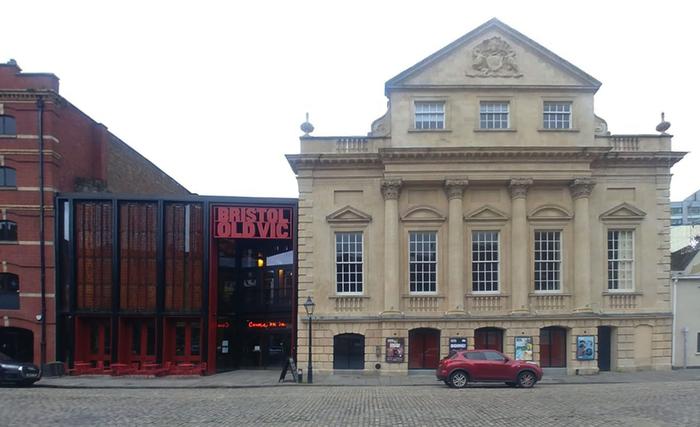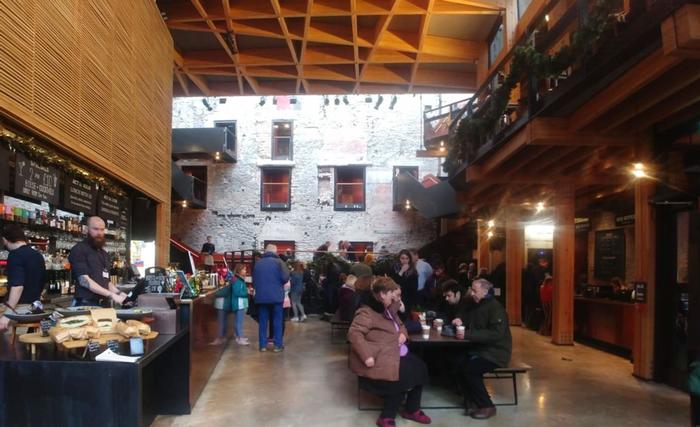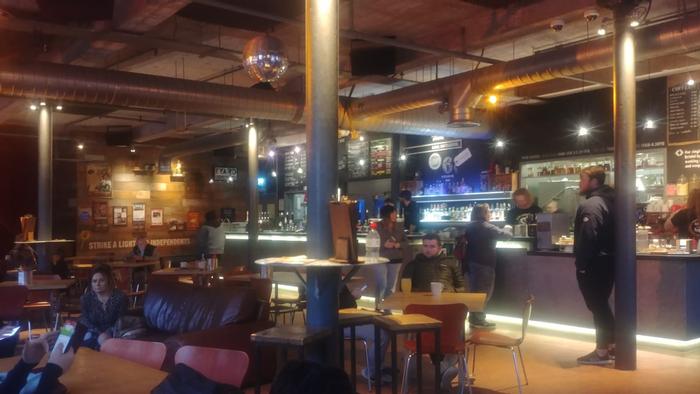Michael Tsang and Elisa Ynaraja Rodriguez - EssayThe Storytellers of Bristol: An Exploration of Community Created by TheatrePREFACE The education of architects and civil engineers at our university is a combined one in which we routinely collaborate in joint projects. The selected buildings were only possible through the collaboration between these two disciplines, thus it was only natural that we work together in researching this year’s topic. ACT I - EXPOSITION ‘Brycgstow’ - Old English for ‘the bridge place’. This is the story of an Anglo-Saxon village in Southwest England that would grow to become one of the British Empire’s leading ports for trade with the New World. This is the story of ‘one of the birthplaces of the Industrial Revolution’, home to industries including wool, soap, sugar and tobacco. This is the story of Bristol. Undeniably attributing to the city’s success story in trade and industry was Bristol’s involvement in the Slave Trade, with its many merchants bringing fortune through ownership of slaves and sugar plantations. Many of the city’s civic institutions emerged out of this economic boom, including the Bristol Old Vic (BOV) - the longest-running theatre in the English-speaking world - for which evidence may be found exhibited within the building itself, in the form of silver tickets inscripted “The bearer/Proprietor of this Ticket is entitled to the sight of every performance to be exhibited in this house”. Each of the theatre's fifty original benefactors received such a token, amongst which at least twelve were slave merchants or owners of slave ships, and another six were suppliers to sugar traders or plantation owners. Amongst Bristol’s industries tobacco was a notably influential character. The W.D. & H.O. Wills Company, which began life as a small shop in Bristol in 1786, would grow to become one of the world’s largest tobacco manufacturers. The Wills Tobacco Family would have a significant influence over Bristol’s story with Sir Frank Wills, later Lord Mayor of Bristol, as architect of the original Tobacco Factory (TF) building that would later emerge as a theatre at the heart of the urban regeneration of the Southville neighbourhood in the 1990s. In exploring these stories therein lies the argument - the very act of ‘storytelling’ possesses the power to create community. This empathetic process of sharing one’s story with another facilitates the formation of the social ties that form the building blocks of community, and the theatre, as a piece of social infrastructure, is the architectural manifestation of this endeavour. Stories, however, are never without context, for a story always connects into a wider story. In the case of our protagonists, the BOV and the TF, their stories feed into the wider context of Bristol - the former echoing the city’s redressing of its conflicted past and the latter reflecting the city’s rebellious streak. Therein lies the second layer to the argument - in feeding their own stories into the wider story of Bristol, the communities fostered within these two buildings similarly extend to the wider city. ACT II - REDRESS The BOV, formerly the Theatre Royal, came into existence in 1766 during the years of the Slave Trade owing, at least partially, to the funds of slave traders and merchants. At the time the theatre was technically illegal, not possessing a Royal Charter, and thus had to be hidden behind street-facing houses. The building has since undergone numerous redevelopments including work in the 1970s that still closed much of the building off from the street, yet most recently the redevelopment by architects Haworth Tompkins completed in 2018 has finally remedied this, revealing the fabric of the original building to the public realm. In this sensitive redevelopment one begins to observe moves being made to redress the city’s conflicted past. No doubt referencing the palladian composition of the neighbouring Coopers’ Hall, the BOV’s new face-lift comprises three triple-height bays with ground floor openings and shutters above. Accompanying this triplet is an entrance, both recessed and angled as to mirror that of the original theatre itself, with bold red letters above reading ‘BRISTOL OLD VIC’, proudly announcing its presence as to redress its former hidden state. Upon closer inspection of the aforementioned double-height shutters one may discern the appearance of words more subtle - these are the inaugural words of actor David Garrick in what was the first ever performance on stage in this theatre, in addition to the poem ‘Bristol Bristol!’ by former Bristol poet laureate Miles Chambers, which addresses the city’s ‘historical hangover’. This gesture of immortalising these words acknowledges Bristol’s past and is a subtle redressal which may be seen as a first step towards bringing in the city’s marginalised Afro-Carribean community, for whom the effects of the Slave Trade are arguably still felt. In 2017 the University of Manchester’s Centre on Dynamics of Ethnicity in collaboration with the Runnymede Trust, a race-equality think-tank, published a report highlighting Bristol’s problem with racial inequality, with the city ranked 7th worst out of 348 districts in England and Wales. The following year the BOV was involved in jointly organising a series of ‘City Conversations’ in an effort to reduce racial divisions whilst re-examining the ‘city's relationship with the slave trade, and how to move forward’. This response, which is but one amongst many, to the revelations of the Runnymede Report demonstrates the wider movement in Bristol in redressing its Slave Trade past and its lasting influence on the city’s communities today, and in doing so highlights the importance of dialogue in bridging such division between communities. As a place of performance, the BOV arguably holds a great responsibility in initiating such dialogue; its most recent architectural language amplifies this. Visible behind the front facade is the new foyer. Like a civic square it spills out to the street, yet this urban reach aside, it is effectively another performance space, albeit an informal one flanked by bar and reception. Towards the rear a subtly raised level forms an impromptu stage, the masonry of the original theatre immediately behind forming the backdrop. Key to the success of this foyer space was Momentum Structural Engineers’ weaving of the timber diagrid roof within the existing structure, celebrating the presence of both as to tie together the conflicted past with the present in a space that welcomes any and all to engage in community discussion. The significance of this is the recognition of the influence of the city’s conflicted past in present day life and the importance of openly discussing this in order to remedy the impact on Bristol’s marginalised communities. One can of course not discuss the BOV without mention of the adjoining Coopers’ Hall, which in the 1970s was incorporated as the theatre’s primary entrance and circulation. The public room originally situated within the hall’s upper level has now been restored as a space suitable for weddings and events-hire. Beneath, the new ‘Weston Studio’, has been carefully engineered by Max Fordham Engineering to allow for controlled natural lighting and ventilation. The addition of this new performance space has provided the BOV with greater freedom in hosting smaller productions, in particular the recent ‘Missing Pieces' season. This series of shows, directed and performed by black actors, focused on black issues - 'Crowning Glory' for example tells the story of the pressures suffered by black women with regards to their hair in the face of Western beauty standards. By celebrating such compelling stories and diversifying its portfolio, the BOV makes further moves of redressal, bringing this marginalised community to the foreground whilst inviting the wider community to engage in this important dialogue. ACT III - REBELLION In our current climate of divisive discourse and polarising politics, rebellion is unavoidably familiar to us all. Bristol, as a largely left-leaning city, has been home to many protests - most recently the calls of Extinction Rebellion in response to the ongoing Climate Crisis. The revival of the TF from a derelict industrial shell into a mixed-use cultural hub with theatre at its heart, by architect-turned-politician George Ferguson in the 1990s, predates our current climate, yet from its conception to this day continues this rebellious streak. In order to understand the significance of this one must first look back to the history of Southville prior to the TF’s emergence as a theatre. Originally named ‘Number 3 Factory’, the building once sat as part of a larger industrial site, which at its peak provided employment for more than 40% of the local working population. In the 1970s, however, the tobacco industry moved to the outskirts of the city, leaving behind mass unemployment alongside these red-brick shells. Many were subsequently demolished, and this too was to be the fate of the former ‘Number 3 Factory’. It was only by the rebellious whim of architect George Ferguson that the factory was saved from demolition. Purchasing the building in 1993 he then commenced the impromptu process of redeveloping the TF into a mixed-use community hub, home to independent businesses with ‘the arts at its core’. Ferguson was adamant that the TF project be arts-led, emphasising the performing arts. He soon welcomed a small local theatre company, ‘Show of Strength’, to occupy the dilapidated building and after setting up the bare essentials they began to put on shows. Using a single mobile phone as the Box Office, their first production of Shakespeare received critical acclaim and was a great success that would mark the beginning of the TF’s life in theatre production. The success of this first show no doubt provided the recognition, to this group of rebels, necessary to cement their position in Southville, and arguably is evidence of the first signs of a renewed community. Other functions soon followed - a cafebar, Sunday market, offices and apartments - as the TF truly became a mixed-use community hub. Underpinning the addition of all these mixed uses was Ferguson’s ‘Strike A Light For Independents’ campaign with the aim of promoting independent businesses and outlets. This philosophy of Ferguson’s in regenerating the TF would hold wider significance for the city of Bristol in characterising his political career as he successfully ran for the post of the city’s first elected Mayor in 2012, serving until 2016 and defeating the favourite - now incumbent Mayor Marvin Rees - of the Labour Party, and interestingly mirroring the civic role that the TF’s original architect Sir Frank Wills took on when becoming Lord Mayor of Bristol a century before. This rebellious campaign of Ferguson’s which characterised his civic life cannot be denied its influence in the city of Bristol - his election as Mayor is evidence of the successful reach of this rebellious streak and demonstrates the growth of a community that began in this once abandoned red-brick shell. What one may observe now when walking down North Street is a rejuvenated high street, home to a host of independent retail outlets, the urban regeneration catalysed by the TF having, according to local shopkeepers, ‘brought a lot of people back to the area’. Outdoor markets regularly occupy the TF’s car park on one side of the building as a meeting place for locals, whilst on the opposite side facing into the adjacent supermarket’s car park, mural’s adorn the building’s wall - currently the face of the Extinction Rebellion Movement, Greta Thunberg’s portrait, occupies this prime spot. Such graffiti is not uncommon in this neighbourhood, which is home to Upfest, ‘Europe's largest Street Art & Graffiti festival’, and further illustrates the rebellious character which unites the TF community. Unlike the bold new entrance of the BOV, the retrofit of the TF is far more subtle - in essence it is primarily a reconfiguration of the interior layout, enabled by the open plan and high ceilings of the original factory building. Internally Ferguson Mann Architects’ ‘hands-off approach’ can be seen through the use of colour and materiality in order to mark a clear distinction between what is old and new. Exposed ductwork and services are visible throughout and the original steel columns stand proud but with the addition of round desktops circling around them in the cafebar such that they may double up as essential seating space. This cafebar space is key to the building’s success, home to not only the food and drink offerings of the community hub, but also as the primary meeting space. Local volunteers, the ‘BS3’ group, regularly meet in this very cafebar where new members looking to get to know their neighbours may join and engage with this community - in this way the architecture inspires civic engagement. This ‘hands-off approach’ continues upstairs into the theatre where the columns again stand proud within the stage, there to be integrated into one’s performance. Like the BOV, the TF also recently completed redevelopments in late 2018 with the addition of the new ‘Spielman Studio’ allowing for more performances and workshops to be hosted. The recent ‘Queer Space’ workshop for example was a performance workshop open to anyone identifying as LGBT+, another historically marginalised yet rebellious community. In this way the TF both diversifies and extends its community. CONCLUSION In witnessing the story of the BOV it becomes clear that it is beginning to extend its existing community. With the new entrance foyer, the building welcomes citizens and encourages civic engagement, whether by listening or performing, and with the new Weston Studio hosting the likes of the ‘Missing Pieces’ season, the theatre celebrates the city’s marginalised communities, bringing them to the foreground for dialogue. Just as the new timber diagrid structure has been weaved into the existing fabric, the BOV is working to similarly bring together divided communities, and evidently driving this is the effort to redress the city’s conflicted past. The success of the TF at the heart of the urban regeneration of Southville speaks to the power of civic buildings in creating community. In respecting the original building with a ‘hands-off approach’, the existing community of former factory employees has similarly been respected - in fact they are part of the heritage that is evident in the architecture. This strong heritage, much like in the case of the BOV, in combination with the building’s renewed purpose as a theatre-led mixed-use hub, forms a powerful magnet that attracts new rebels to this community. Ultimately the success of these two civic buildings comes down to their nature as both retrofit and mixed-use projects. A comparison of the two reveals a shift of the BOV towards becoming a piece of social infrastructure more akin to that of the TF, as the former becomes a more welcoming hub, introducing elements of mixed-use as exemplified by its new foyer which sits comfortably within the heritage of its site. This can be attributed to the success of the TF which, from a derelict shell, emerged out of the civic engagement of a few rebels to establish a strong sense of renewed community - the BOV no doubt wishes to emulate this as it seeks to encourage civic engagement in its efforts to redress its conflicted past. Yet with the BOV having celebrated its 250th anniversary in 2016 and the TF its 25th anniversary in 2019, one can imagine that both pieces of social infrastructure still have many more to celebrate with their flourishing communities. (References available upon Request) Additional Help and InformationAre you in need of assistance? Please email info@berkeleyprize.org. |




